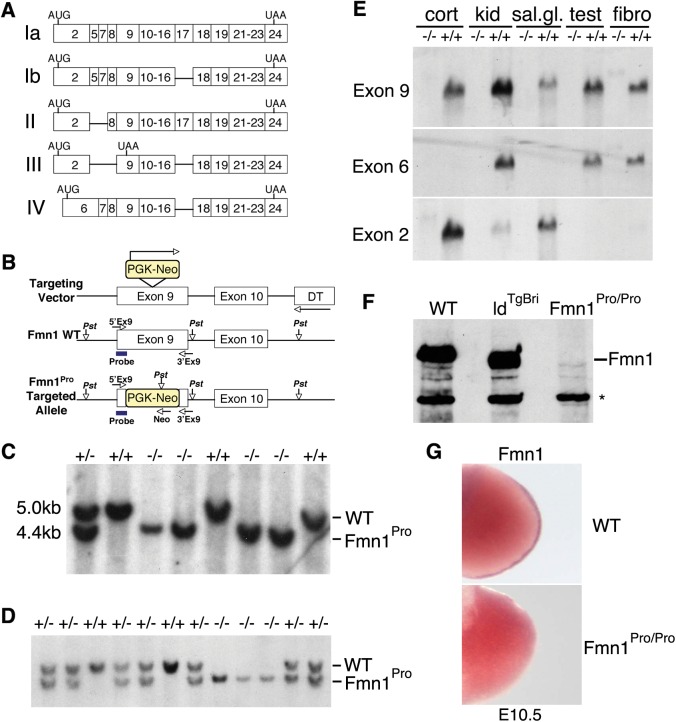Figure 1.
Generation and expression pattern characterization of Fmn1Pro/Pro mice. (A) Depiction of the major splice variants expressed from the Fmn1 allele are marked as Ia, Ib, II, III and IV. Boxes filled with numbers running from 2 to 24 indicate the exons expressed within each of the splice variants. AUG and UAA correspond to positions of the translational start and stop sites, respectively (schematic diagram adapted from 24). (B) Shown is the targeting scheme for disruption of exon 9 of Fmn1, by insertion of a PGK-Neo cassette (yellow box). WT and Fmn1Pro targeted alleles are shown. The positions of the PstI restriction enzyme sites are shown. The probe used for Southern blotting is positioned (blue line) at the 5′ end of exon 9. PCR primers used for genotype analysis are shown as 5′Ex9, 3′Ex9 and Neo with an arrow indicating the orientation of the primers. (C) Representative Southern blot analysis of tail DNA derived from Fmn1Pro allelic disruption mice, digested with PstI and hybridized to a probe derived from the 5′ end of exon 9. (D) Representative 3-primer PCR genotyping from tail DNA derived from Fmn1Pro allelic disruption mice. (E) Northern blots of polyadenylated-positive RNA derived from tissues of wild-type, +/+, or Fmn1Pro/Pro, −/−, mice. Northern blots were probed for expression of transcripts containing sequences derived from exons 9, 6 and 2, as indicted to the left of the blots. Abbreviations used: cerebral cortex, cort; kidney, kid; salivary gland, sal.gl.; testis, test; embryo fibroblasts, fibro. (F) Western blot of mouse embryo fibroblast protein extracts derived from wild-type, ldTgBri, and Fmn1Pro/Pro mice, probed with anti-Fmn1 rabbit antiserum. The full-length Fmn1 protein is indicated, and an unrelated cross-reactive band is labeled with *. (G) Expression pattern of Fmn1 in limb bud. Embryonic stage 10.5 wild-type and Fmn1Pro/Pro limb buds probed for RNA expression by in situ hybridization with a probe to Fmn1.

